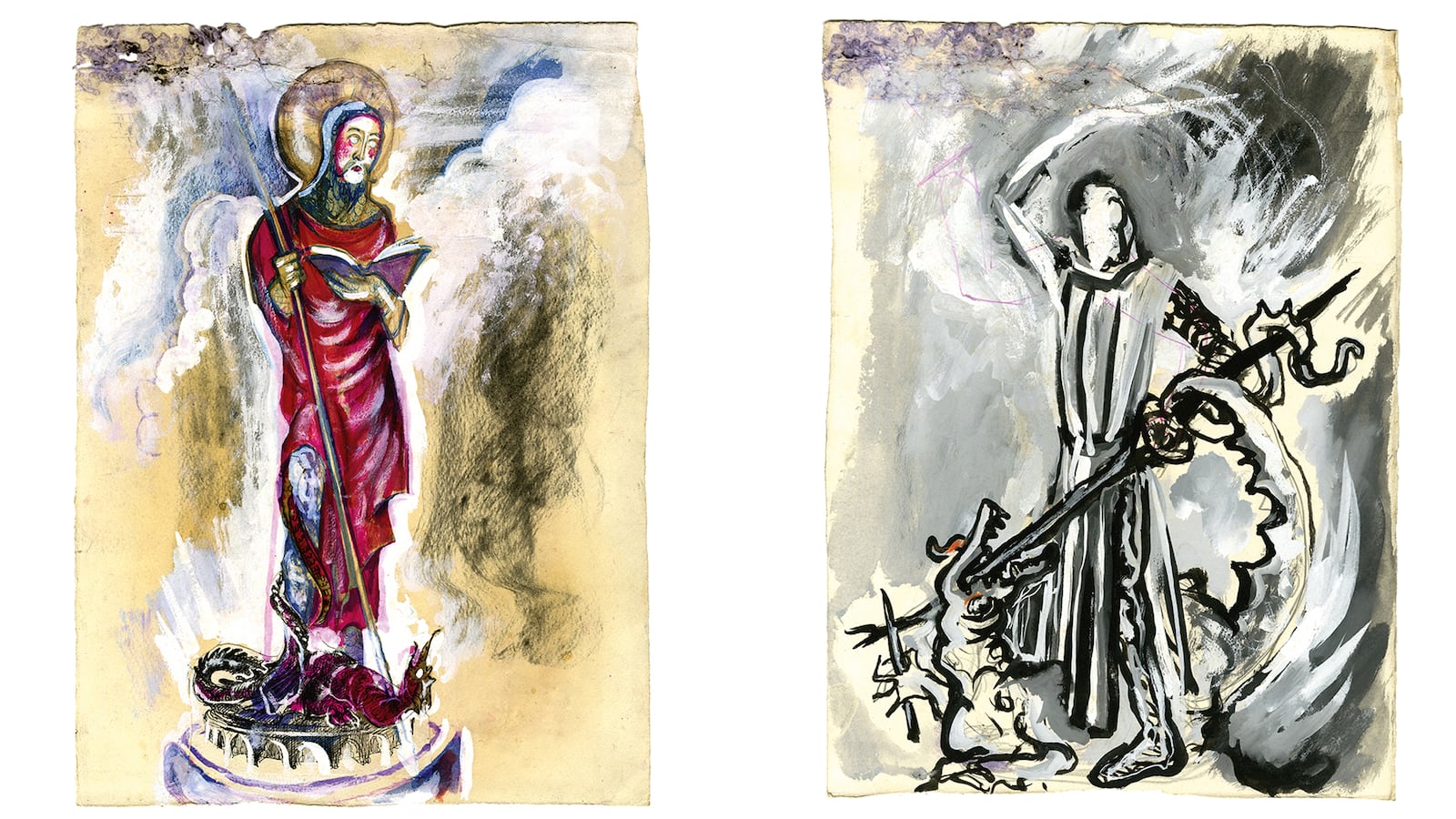Orson Welles could draw and paint quite well. What a shock. Was there anything he couldn’t do? If you told me he designed his own clothes, invented a dripless faucet, or discovered a new planet in the solar system, I wouldn’t bat an eye. He was what we once called a Renaissance man, a term that’s fallen out of favor lately because in this age of specialization, it’s impossible to imagine someone who could, say, paint, write poetry, master mathematics, and design a flying machine, as Leonardo did. Hell, even generalists are in short supply these days.

Matador oil painting
© Beatrice Welles Inc. and the Estate of Orson Welles. Taken from Orson Welles Portfolio by Simon Braund, published by Titan BooksMulti-talented people do still exist. Latest example: I was plenty impressed just this week while watching the last episode of Russian Doll on Netflix when I noticed that not only did Natasha Lyonne co-create and star in the mini-series but also wrote and directed the last episode all by her lonesome.
But Welles really did outdo everyone. He not only starred on Broadway while still in his twenties but started and ran his own theater company. He mastered radio drama and created the most famous radio play of all time (the 1938 War of the Worlds episode that left more than a few listeners convinced they’d just tuned in to an actual broadcast about an alien invasion). When he went to Hollywood, he wrote, directed, and starred in his first movie, and we all know how that turned out.

Citizen Kane Citizen Kane Orson Welles
AlamyThe problem with making Citizen Kane (1941) as your first film is that a) it’s tough to come up with a follow-up act and b) you get pigeonholed for the rest of your life as the person who made Citizen Kane, as if that’s all you ever accomplished. Welles had little problem with part a. He turned right around and made The Magnificent Ambersons, which even in the butchered version the studio released is still, well, magnificent. As for the reductive part b, there worse things than being known only as the star, director, and co-writer of what’s often called the best movie of all time.
Still, it’s worth emphasizing that he did make other great movies, at least a couple of which are much more fun to watch than Kane. Touch of Evil (1958) has lately begun to get the attention and praise it deserves, and maybe some day Chimes at Midnight (1965)will also get its due as the best filmed version of Shakespeare and a movie that possesses extraordinary emotional depth, not to mention the best battle scene ever filmed.

Anyone familiar with those films should not be surprised that Welles was a great draughtsman. His movies are all visual feasts. And while he did nearly always hire great cinematographers to shoot those films, he plainly had a lot to say about shot selection and visual style, because they all look somewhat similar. They look like Welles movies.
A fascinating new coffee table book, Orson Welles Portfolio: Sketches and Drawings From the Welles Estate, collects hundreds of his works on paper: ideas for costumes in plays and movies, hand-drawn Christmas cards, doodles, architectural studies, bullfighting paintings, cartoons, and mocking self-portraits. The best look dashed off. The more he tried to finish something, the more the life leeches out of it.

Moby Dick notecards front
© Beatrice Welles Inc. and the Estate of Orson Welles. Taken from Orson Welles Portfolio by Simon Braund, published by Titan Books
Christmas cards front and corresponding interiors
© Beatrice Welles Inc. and the Estate of Orson Welles. Taken from Orson Welles Portfolio by Simon Braund, published by Titan BooksThis was in keeping with the rest of his work. As he grew older, and as financing for his movies became ever more problematic, he took forever to finish a movie, and you can’t help but surmise that he liked it that way. “That’s a wrap” are three words he plainly hated saying.

Watercolor illustration; Vogue Paris No 632
© Beatrice Welles Inc. and the Estate of Orson Welles. Taken from Orson Welles Portfolio by Simon Braund, published by Titan Books
Unidentified costume design
© Beatrice Welles Inc. and the Estate of Orson Welles. Taken from Orson Welles Portfolio by Simon Braund, published by Titan Books
Unidentified costume design
© Beatrice Welles Inc. and the Estate of Orson Welles. Taken from Orson Welles Portfolio by Simon Braund, published by Titan BooksI think he much preferred the process to the end product. The Other Side of the Wind, the film he was working on for the last few years before he died, has been completed posthumously by his friend Peter Bogdanovich and others and can currently be seen on Netflix. This story of an aging Hollywood film director played by John Huston is pretty much a train wreck of a movie, but it’s a fascinating train wreck, with scenes and shots that make you gasp. The parts really are greater than the whole. The film is in many ways the equivalent of the newly published drawings: the best parts don’t seem finished but they glisten with life.

Costume design; Mogu of the Desert
© Beatrice Welles Inc. and the Estate of Orson Welles. Taken from Orson Welles Portfolio by Simon Braund, published by Titan Books
Two unidentified St. George slaying the dragon statue watercolor sketches
© Beatrice Welles Inc. and the Estate of Orson Welles. Taken from Orson Welles Portfolio by Simon Braund, published by Titan Books
Paris postcards
© Beatrice Welles Inc. and the Estate of Orson Welles. Taken from Orson Welles Portfolio by Simon Braund, published by Titan BooksIf Welles had a problem, aside from a Hollywood establishment that wanted nothing to do with him, it was an over-abundance of talent. I know, we should all have such a problem. If he had only been good at theater, or drawing, or acting, or directing, or editing, he might have achieved more. As it was, he was constantly having to choose which of his gifts to employ on a given day. The miracle, in a strange way, is that he managed to bear down and focus long enough to give us at least three or four great movies that will last forever.

One more thing, to round out that résumé: He was reputedly a very good stage magician. In World War II he entertained the troops by sawing his fiancée, Rita Hayworth, in half.


